2009 Hyundai Santa Fe ESP
[x] Cancel search: ESPPage 154 of 269
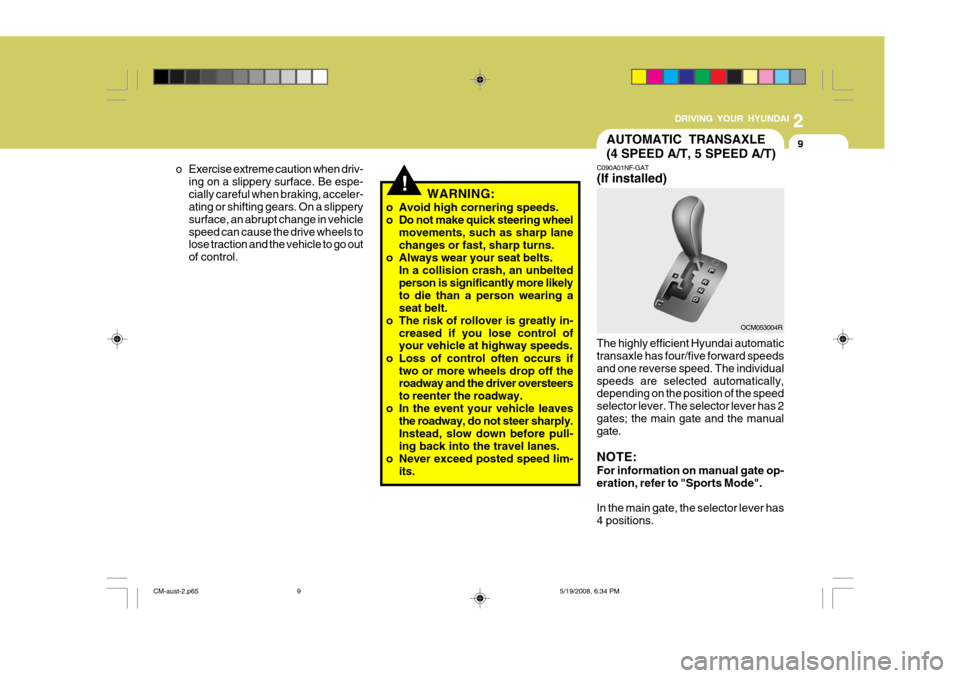
2
DRIVING YOUR HYUNDAI
9
!
o Exercise extreme caution when driv-
ing on a slippery surface. Be espe- cially careful when braking, acceler- ating or shifting gears. On a slippery surface, an abrupt change in vehiclespeed can cause the drive wheels to lose traction and the vehicle to go out of control. WARNING:
o Avoid high cornering speeds.
o Do not make quick steering wheel movements, such as sharp lanechanges or fast, sharp turns.
o Always wear your seat belts.
In a collision crash, an unbelted person is significantly more likely to die than a person wearing aseat belt.
o The risk of rollover is greatly in- creased if you lose control of your vehicle at highway speeds.
o Loss of control often occurs if two or more wheels drop off theroadway and the driver oversteers to reenter the roadway.
o In the event your vehicle leaves
the roadway, do not steer sharply.Instead, slow down before pull- ing back into the travel lanes.
o Never exceed posted speed lim- its.
AUTOMATIC TRANSAXLE (4 SPEED A/T, 5 SPEED A/T)
C090A01NF-GAT (If installed)
The highly efficient Hyundai automatic transaxle has four/five forward speeds and one reverse speed. The individualspeeds are selected automatically, depending on the position of the speed selector lever. The selector lever has 2gates; the main gate and the manual gate. NOTE: For information on manual gate op- eration, refer to "Sports Mode". In the main gate, the selector lever has 4 positions.
OCM053004R
CM-aust-2.p65 5/19/2008, 6:34 PM
9
Page 158 of 269
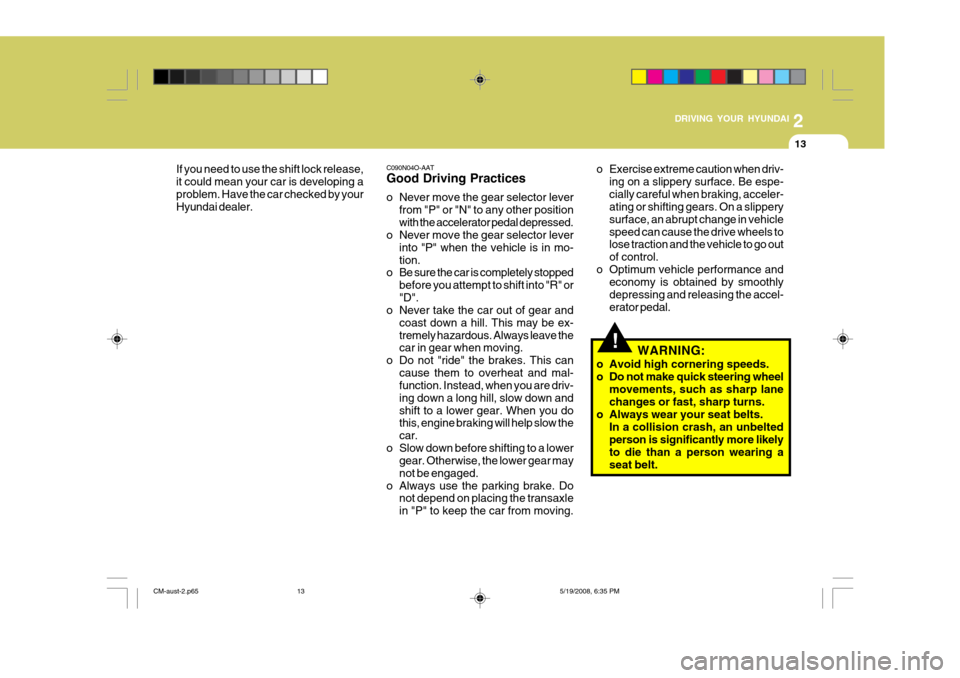
2
DRIVING YOUR HYUNDAI
13
!
C090N04O-AAT Good Driving Practices
o Never move the gear selector lever
from "P" or "N" to any other position with the accelerator pedal depressed.
o Never move the gear selector lever
into "P" when the vehicle is in mo-tion.
o Be sure the car is completely stopped
before you attempt to shift into "R" or"D".
o Never take the car out of gear and
coast down a hill. This may be ex-tremely hazardous. Always leave the car in gear when moving.
o Do not "ride" the brakes. This can cause them to overheat and mal-function. Instead, when you are driv- ing down a long hill, slow down andshift to a lower gear. When you do this, engine braking will help slow the car.
o Slow down before shifting to a lower gear. Otherwise, the lower gear maynot be engaged.
o Always use the parking brake. Do not depend on placing the transaxlein "P" to keep the car from moving.
If you need to use the shift lock release,it could mean your car is developing aproblem. Have the car checked by your Hyundai dealer.
o Exercise extreme caution when driv-
ing on a slippery surface. Be espe- cially careful when braking, acceler- ating or shifting gears. On a slippery surface, an abrupt change in vehiclespeed can cause the drive wheels to lose traction and the vehicle to go out of control.
o Optimum vehicle performance and economy is obtained by smoothlydepressing and releasing the accel-erator pedal.
WARNING:
o Avoid high cornering speeds.
o Do not make quick steering wheel movements, such as sharp lane changes or fast, sharp turns.
o Always wear your seat belts. In a collision crash, an unbelted person is significantly more likelyto die than a person wearing a seat belt.
CM-aust-2.p65 5/19/2008, 6:35 PM
13
Page 159 of 269

2DRIVING YOUR HYUNDAI
14
o The risk of rollover is greatly in-
creased if you lose control of your vehicle at highway speeds.
o Loss of control often occurs if two or more wheels drop off theroadway and the driver oversteers to reenter the roadway.
o In the event your vehicle leaves the roadway, do not steer sharply.Instead, slow down before pull- ing back into the travel lanes.
o Never exceed posted speed lim- its.
o If your vehicle becomes stuck in
snow, mud, sand, etc., then youmay attempt to rock the vehicle free by moving it forward andbackward. Do not attempt this procedure if people or objects are anywhere near the vehicle.During the rocking operation the vehicle may suddenly move for- ward of backward as it becomesunstuck, causing injury or dam- age to nearby people or objects.!WARNING:
Your ABS (ESP) will not prevent accidents due to improper or dan-gerous driving manoeuvres. Even though vehicle control is improved during emergency braking, alwaysmaintain a safe distance between you and objects ahead. Vehicle speeds should always be reducedduring extreme road conditions. The braking distance for cars equipped with an anti-lock brakingsystem (the electronic stability pro- gram) may be longer than for those without it in the following road con-ditions. These roads should be driven at reduced speeds.
o Rough, gravel or snow-covered roads.
o With tyre chains installed.
o On roads where the road surface is pitted or has different surface height.
ANTI-LOCK BRAKE SYSTEM
C120A01FC-DAT The Anti-Lock Brake System (ABS) is designed to prevent wheel lock-up dur- ing sudden braking or on hazardous road surfaces. The ABS control modulemonitors the wheel speed and controls the pressure applied to each brake. Thus, in emergency situations or onslick roads, ABS will increase vehicle control during braking. NOTE:
o A click sound may be heard in the engine compartment when the vehicle begins to move after the engine is started. These condi- tions are normal and indicate thatthe anti-lock brake system (Elec- tronic Stability Program) is func- tioning properly.
o During ABS (ESP) operation, a
slight pulsation may be felt in thebrake pedal when the brakes are applied. Also, a noise may be heard in the engine compartmentwhile braking. These conditions are normal and indicate that the anti-lock brake system (ElectronicStability Program) is functioning properly.
CM-aust-2.p65 5/19/2008, 6:35 PM
14
Page 160 of 269
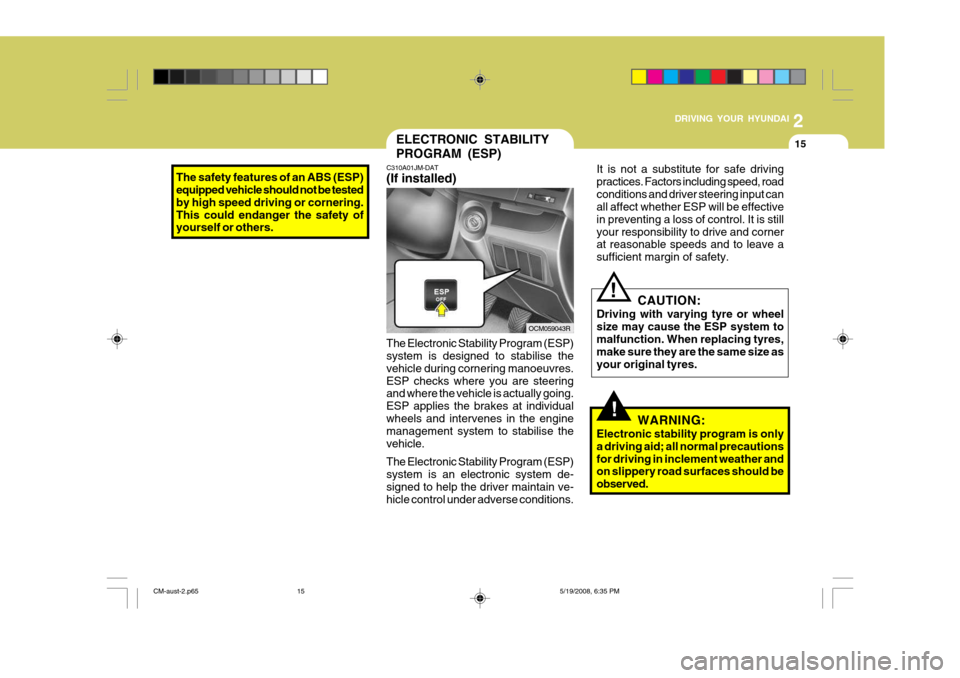
2
DRIVING YOUR HYUNDAI
15
The safety features of an ABS (ESP) equipped vehicle should not be tested by high speed driving or cornering.This could endanger the safety of yourself or others.
!
It is not a substitute for safe driving practices. Factors including speed, roadconditions and driver steering input can all affect whether ESP will be effective in preventing a loss of control. It is stillyour responsibility to drive and corner at reasonable speeds and to leave a sufficient margin of safety.
CAUTION:
Driving with varying tyre or wheelsize may cause the ESP system to malfunction. When replacing tyres, make sure they are the same size asyour original tyres.
WARNING:
Electronic stability program is onlya driving aid; all normal precautionsfor driving in inclement weather and on slippery road surfaces should be observed.
!
ELECTRONIC STABILITY PROGRAM (ESP)
C310A01JM-DAT (If installed) The Electronic Stability Program (ESP) system is designed to stabilise the vehicle during cornering manoeuvres.ESP checks where you are steering and where the vehicle is actually going. ESP applies the brakes at individualwheels and intervenes in the engine management system to stabilise the vehicle. The Electronic Stability Program (ESP) system is an electronic system de-signed to help the driver maintain ve- hicle control under adverse conditions. OCM059043R
CM-aust-2.p65
5/19/2008, 6:35 PM
15
Page 161 of 269
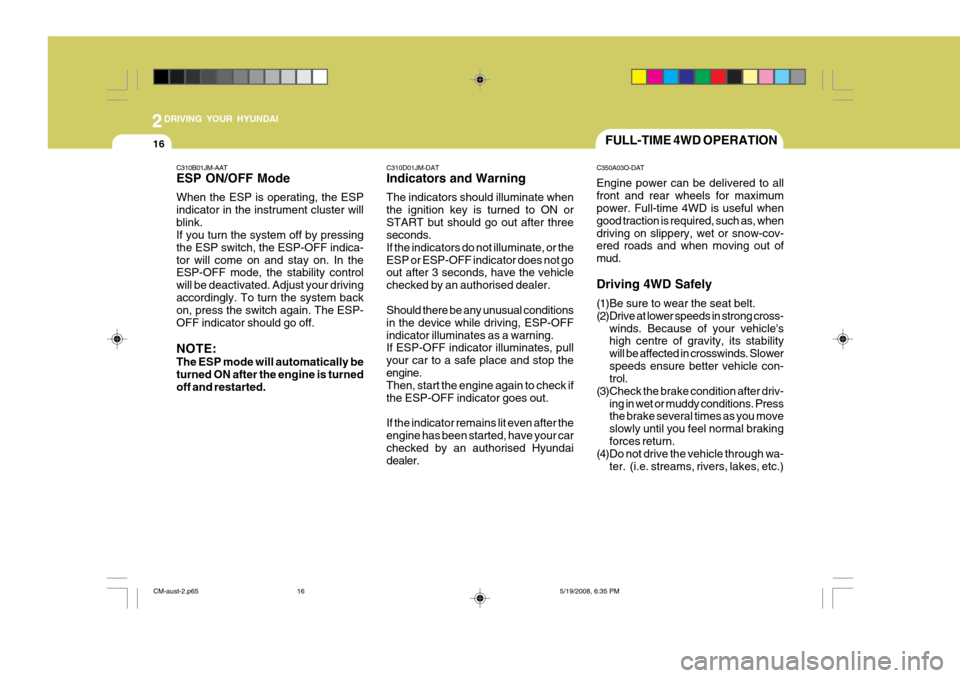
2DRIVING YOUR HYUNDAI
16FULL-TIME 4WD OPERATION
C350A03O-DAT Engine power can be delivered to all front and rear wheels for maximum power. Full-time 4WD is useful when good traction is required, such as, whendriving on slippery, wet or snow-cov- ered roads and when moving out of mud. Driving 4WD Safely
(1)Be sure to wear the seat belt.
(2)Drive at lower speeds in strong cross- winds. Because of your vehicle's high centre of gravity, its stability will be affected in crosswinds. Slowerspeeds ensure better vehicle con- trol.
(3)Check the brake condition after driv- ing in wet or muddy conditions. Pressthe brake several times as you move slowly until you feel normal brakingforces return.
(4)Do not drive the vehicle through wa-
ter. (i.e. streams, rivers, lakes, etc.)
C310B01JM-AAT ESP ON/OFF Mode When the ESP is operating, the ESP indicator in the instrument cluster willblink. If you turn the system off by pressing the ESP switch, the ESP-OFF indica-tor will come on and stay on. In the ESP-OFF mode, the stability control will be deactivated. Adjust your drivingaccordingly. To turn the system back on, press the switch again. The ESP- OFF indicator should go off. NOTE: The ESP mode will automatically be turned ON after the engine is turnedoff and restarted.
C310D01JM-DAT Indicators and Warning The indicators should illuminate when the ignition key is turned to ON orSTART but should go out after three seconds. If the indicators do not illuminate, or theESP or ESP-OFF indicator does not go out after 3 seconds, have the vehicle checked by an authorised dealer. Should there be any unusual conditions in the device while driving, ESP-OFFindicator illuminates as a warning. If ESP-OFF indicator illuminates, pull your car to a safe place and stop theengine. Then, start the engine again to check if the ESP-OFF indicator goes out. If the indicator remains lit even after the engine has been started, have your carchecked by an authorised Hyundai dealer.
CM-aust-2.p65
5/19/2008, 6:35 PM
16
Page 164 of 269
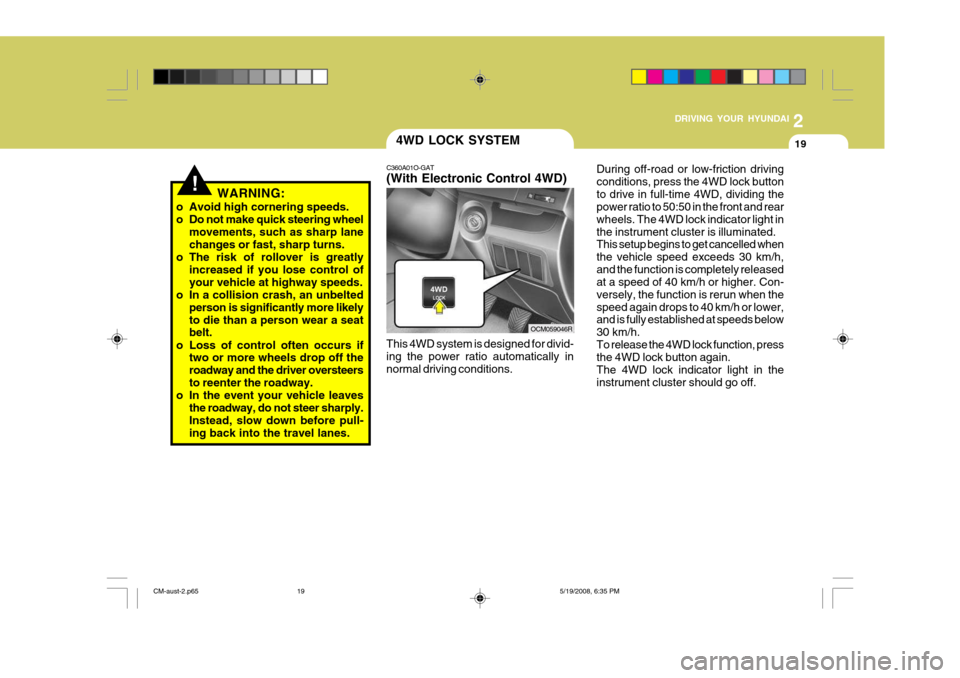
2
DRIVING YOUR HYUNDAI
19
!
4WD LOCK SYSTEM
C360A01O-GAT (With Electronic Control 4WD) This 4WD system is designed for divid- ing the power ratio automatically innormal driving conditions. During off-road or low-friction drivingconditions, press the 4WD lock buttonto drive in full-time 4WD, dividing the power ratio to 50:50 in the front and rear wheels. The 4WD lock indicator light inthe instrument cluster is illuminated. This setup begins to get cancelled when the vehicle speed exceeds 30 km/h,and the function is completely released at a speed of 40 km/h or higher. Con- versely, the function is rerun when thespeed again drops to 40 km/h or lower, and is fully established at speeds below 30 km/h.To release the 4WD lock function, press the 4WD lock button again. The 4WD lock indicator light in theinstrument cluster should go off.
OCM059046R
WARNING:
o Avoid high cornering speeds.
o Do not make quick steering wheel movements, such as sharp lane changes or fast, sharp turns.
o The risk of rollover is greatly increased if you lose control ofyour vehicle at highway speeds.
o In a collision crash, an unbelted person is significantly more likelyto die than a person wear a seat belt.
o Loss of control often occurs if two or more wheels drop off the roadway and the driver oversteersto reenter the roadway.
o In the event your vehicle leaves the roadway, do not steer sharply. Instead, slow down before pull- ing back into the travel lanes.
CM-aust-2.p65 5/19/2008, 6:35 PM
19
Page 166 of 269

2
DRIVING YOUR HYUNDAI
21
If your car is facing downhill, turn the front wheels into the kerb to helpkeep the car from rolling. If your car is facing uphill, turn the front wheels away from the kerb to help keep thecar from rolling. If there is no kerb or if it is required by other conditions to keep the car from rolling, block thewheels.
o Under some conditions your parking
brake can freeze in the engagedposition. This is most likely to hap- pen when there is an accumulation of snow or ice around or near the rearbrakes or if the brakes are wet. If there is a risk that the parking brake may freeze, apply it only temporarilywhile you put the gear selector lever in "P" (automatic) or in first or re- verse gear (manual transaxle) andblock the rear wheels so the car cannot roll. Then release the parking brake.
o Do not hold the vehicle on the up- grade with the accelerator pedal. Thiscan cause the transaxle to overheat.Always use the brake pedal or park- ing brake.DRIVING FOR ECONOMY
C140A01A-DAT You can save fuel and get more kilometres from your car if you follow these suggestions:
o Drive smoothly. Accelerate at a moderate rate. Don't make "kanga- roo" starts or full-throttle shifts.Maintain a steady cruising speed. Don't race between stoplights. Try to adjust your speed to that of the othertraffic so you don't have to change speeds unnecessarily. Avoid heavy traffic whenever possible. Alwaysmaintain a safe distance from other vehicles so you can avoid unneces- sary braking. This also reduces brakewear.
o Drive at a moderate speed. The faster
you drive, the more fuel your caruses. Driving at a moderate speed, especially on the highway, is one of the most effective ways to reducefuel consumption.
o Don't "ride" the brake. This can in-
crease fuel consumption and alsoincrease wear on these components. o In addition, driving with your foot
resting on the brake pedal may causethe brakes to overheat, which re- duces their effectiveness and may lead to more serious consequences.
o Take care of your tyres. Keep them inflated to the recommended pres-sure. Incorrect inflation, either toomuch or too little, results in unneces- sary tyre wear. Check the tyre pres- sures at least once a month.
o Be sure that the wheels are aligned correctly. Improper alignment canresult from hitting kerb or driving toofast over irregular surfaces. Poor alignment causes faster tyre wear and may also result in other prob-lems as well as greater fuel con- sumption.
o Keep your car in good condition. For better fuel economy and reducedmaintenance costs, maintain your car in accordance with the mainte-nance schedule in Section 5. If you drive your car in severe conditions, more frequent maintenance is re-quired (see Section 5 for details).
CM-aust-2.p65 5/19/2008, 6:35 PM
21
Page 167 of 269
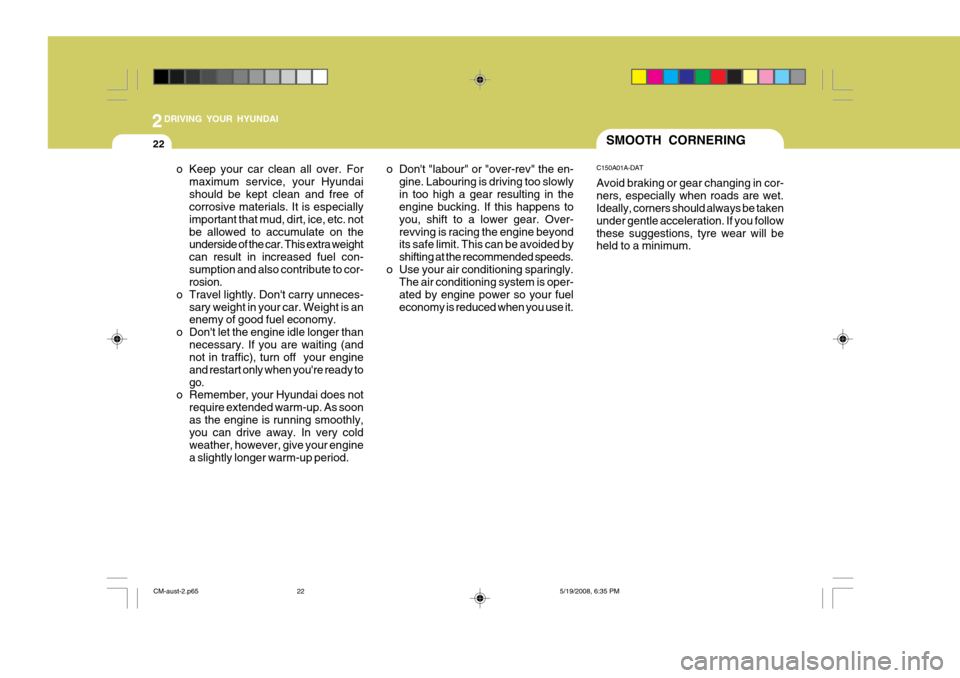
2DRIVING YOUR HYUNDAI
22SMOOTH CORNERING
C150A01A-DAT Avoid braking or gear changing in cor- ners, especially when roads are wet. Ideally, corners should always be taken under gentle acceleration. If you followthese suggestions, tyre wear will be held to a minimum.
o Don't "labour" or "over-rev" the en-
gine. Labouring is driving too slowly in too high a gear resulting in the engine bucking. If this happens to you, shift to a lower gear. Over-revving is racing the engine beyond its safe limit. This can be avoided by shifting at the recommended speeds.
o Use your air conditioning sparingly. The air conditioning system is oper-ated by engine power so your fueleconomy is reduced when you use it.
o Keep your car clean all over. For
maximum service, your Hyundaishould be kept clean and free of corrosive materials. It is especially important that mud, dirt, ice, etc. notbe allowed to accumulate on the underside of the car. This extra weight can result in increased fuel con-sumption and also contribute to cor- rosion.
o Travel lightly. Don't carry unneces- sary weight in your car. Weight is anenemy of good fuel economy.
o Don't let the engine idle longer than
necessary. If you are waiting (andnot in traffic), turn off your engine and restart only when you're ready togo.
o Remember, your Hyundai does not
require extended warm-up. As soonas the engine is running smoothly, you can drive away. In very cold weather, however, give your enginea slightly longer warm-up period.
CM-aust-2.p65 5/19/2008, 6:35 PM
22